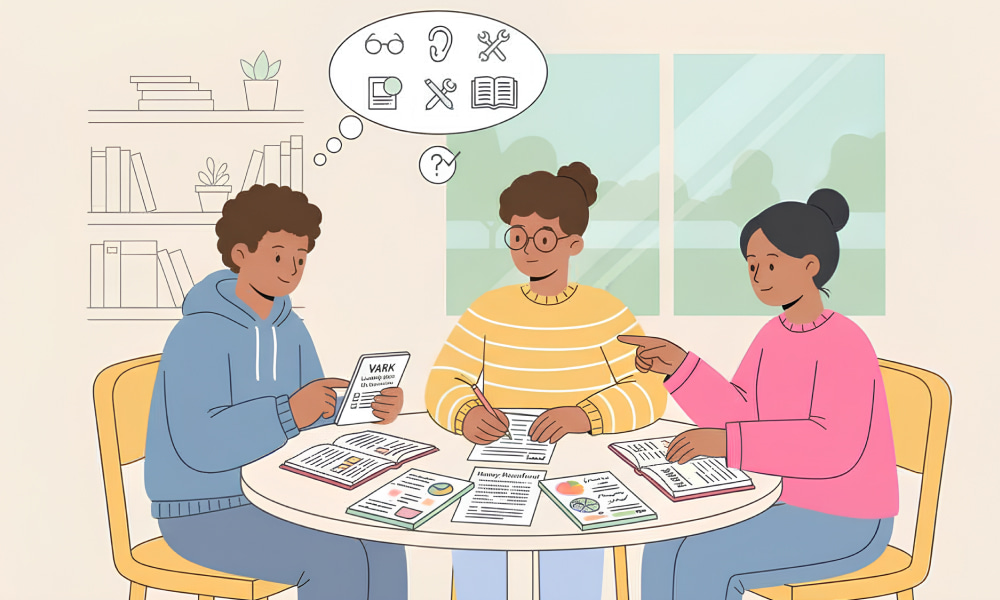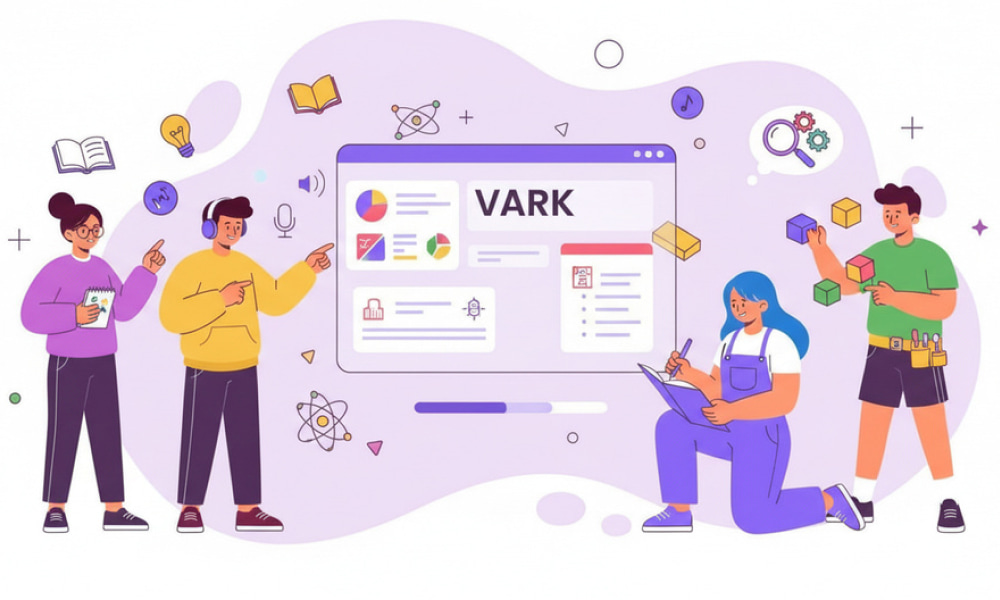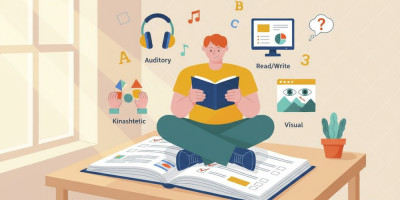VARK Learning Style Questionnaire for Students
New Updates



Take Learning Style Questionnaire Online
Get StartedTransform How You Study With VARK & Kolb Learning Styles Questionnaire
Learning feels effortless when instruction resonates with how the brain prefers to take in information. At its heart, VARK is a pragmatic framework that describes four sensory-centered preferences: Visual, Aural/Auditory, Read/Write, and Kinesthetic. Rather than boxing people in, the model highlights tendencies that can be flexibly combined to improve study tactics, lesson design, and knowledge transfer. The emphasis is on real behaviors in everyday contexts, not abstract labels or fixed traits, which makes it approachable for students, professionals, and lifelong learners alike.
At its core, the what is VARK questionnaire inquiry frames a simple idea about aligning study tactics with sensory channels. By reflecting on common learning situations, you can spot patterns that guide smarter note-taking, richer practice, and more reliable recall. The end goal is practical: build a toolkit that fits you now, then iterate as your tasks, goals, and environments evolve.
Good preference tools avoid jargon, use plain language, and mirror real-world choices. In everyday language, the VARK questionnaire pinpoints whether you lean toward visual, aural, read/write, or kinesthetic cues. That clarity makes it easier to choose methods like diagramming, discussion, annotation, or hands-on rehearsal, and to blend them when a single channel falls short.
- Identify which inputs energize your attention and memory.
- Reduce friction by matching strategies to tasks and contexts.
- Blend modalities to reinforce understanding and long-term retention.
- Communicate preferences to teachers, mentors, and teammates.

How the VARK Model Works and Interprets Modality Patterns
The process begins with a series of scenario-based prompts that feel realistic and situational rather than abstract riddles. Within that flow, a single learning style questionnaire item nudges you to choose what you would actually do in a believable context. The cumulative pattern across items reveals a preference profile that may emphasize one mode or combine several, offering nuance without overcomplication. Because the choices are grounded in everyday tasks, the outcomes typically resonate with lived experience.
After completion, scores aggregate into a profile that may be single-mode or multimodal, revealing nuanced blends. Because the VARK learning styles questionnaire balances everyday choices, the resulting profile tends to mirror natural habits rather than wishful thinking. You can treat the outcome like a compass, not a cage, adapting strategies to the subject, workload, timeline, and performance stakes. Over time, small experiments, such as adding visuals to dense reading or turning lectures into cue-rich outlines, help you refine what truly works.
- Visual prompts: charts, diagrams, timelines, spatial layouts.
- Aural prompts: spoken explanations, peer discussion, podcasts.
- Read/Write prompts: lists, glossaries, summaries, annotations.
- Kinesthetic prompts: labs, simulations, demos, real cases.
Using an Education Questionnaire for Better Learning
Clarity about preference accelerates planning, reduces cognitive overload, and improves retention. In institutional review cycles, an education questionnaire helps instructors spot gaps between delivery methods and learner needs. When coaches and tutors understand how a person absorbs information most naturally, they can calibrate pacing, materials, and feedback toward faster, more durable results. This alignment cuts wasted effort, making study time feel purposeful rather than exhausting.
Organizations that act on evidence from preference profiles tend to design sessions with richer multimodal touchpoints. When a comprehensive learning styles questionnaire guides curriculum tweaks, engagement metrics often climb across diverse cohorts. Learners feel seen, materials become more inclusive, and assessments reflect what participants can truly do. Crucially, the approach works in tandem with universal design, accessibility, and culturally responsive teaching, ensuring equitable participation.
- Boost engagement by matching activities to dominant and secondary modes.
- Elevate recall using spaced, multimodal reinforcement and retrieval practice.
- Streamline lesson planning with reusable, modality-aware templates.
- Strengthen collaboration by making preference discussions routine.
Taking VARK Effectively and Interpreting Results with Confidence
Set aside a quiet moment, answer instinctively, and think about what you actually do, not what you believe you should do. Many learners prefer completing the VARK questionnaire online because the format is quick, accessible, and easy to revisit for reflection. If you feel torn between choices, go with the option that reflects your most common behavior under time pressure, then note exceptions you want to test later.
| Mode | Hallmarks | Study Tactics |
|---|---|---|
| Visual | Prefers diagrams, spatial layouts, color coding | Sketch mind maps, annotate slides, build process flows |
| Aural | Thrives on conversation and spoken explanations | Record summaries, teach peers aloud, join Q&A circles |
| Read/Write | Enjoys lists, definitions, and dense text | Create glossaries, rewrite notes, craft structured outlines |
| Kinesthetic | Needs real cases, movement, and hands-on tasks | Simulate tasks, apply concepts to projects, prototype quickly |
Interpreting the outcome works best when you treat it as a starting point, not a label. If you explore a VARK questionnaire free option, pair it with journaling to capture real-world adjustments and wins. Track which combinations, like diagramming plus explaining aloud, deliver the best comprehension-to-time ratio for each subject or project. Over time, rotate between modalities to reinforce memory traces and prevent plateauing. For broad triangulation, a free learning style questionnaire from a different source can validate or challenge your initial assumptions. When evidence from classes, projects, and performance reviews aligns with your profile, you’ll know the strategies are sticking.
How VARK Compares With Other Influential Models
No single framework owns the whole truth, so comparison sharpens understanding. Fans of experiential cycles often consult the Kolb learning style questionnaire to map learning through concrete experience, reflection, conceptualization, and experimentation. That model emphasizes iterative cycles and can complement VARK’s focus on input channels, giving you both a “how you take it in” view and a “how you transform it” lens. Some educators prefer typologies that speak the language of workplace training and reflective practice. In that tradition, the honey mumford learning style questionnaire frames preferences as Activist, Reflector, Theorist, and Pragmatist to inform facilitation. Pairing these insights with VARK helps planners craft sessions that target both engagement style and sensory preference, which is especially useful in mixed-experience cohorts.

Cross-model triangulation prevents overfitting your study routines to one viewpoint. When teams compare results from the honey and mumford learning styles questionnaire with VARK profiles, they often discover complementary strengths to blend. This synthesis encourages varied activities that deepen understanding while sustaining motivation across long projects or intensive courses. Libraries and advisory centers sometimes keep additional inventories for instructors and coaches. Among these, the index learning styles questionnaire supplies a different axis that can highlight how learners process information and visualize content. Used together, these instruments can illuminate blind spots and spark creative instructional design.
Practical Strategies for Teachers, Trainers, and Self-Learners
Translate your profile into action by adjusting inputs, outputs, and recall techniques. As a planning tool, the VARK learning style questionnaire can inspire lesson templates that weave visuals, discussion, notes, and movement. Start with your dominant mode to gain momentum, then layer secondary modes to consolidate memory and improve transfer to new contexts.
- For Visual emphasis: storyboard lectures, use signaling on slides, and summarize with schematics.
- For Aural emphasis: run Socratic rounds, integrate think-pair-share, and capture micro-podcasts.
- For Read/Write emphasis: distribute structured note frames, term banks, and synthesis prompts.
- For Kinesthetic emphasis: build labs, role-play scenarios, and tactile demonstrations.
- For multimodal balance: sequence activities, see it, hear it, write it, do it, in tight loops.
- For assessment: allow varied evidence of learning, from annotated briefs to narrated walkthroughs.
Students benefit from simple habits that reduce friction and increase meaningful practice. For campus programs, a concise learning style questionnaire for students makes orientation workshops more interactive and personalized. Advisors can then recommend modality-matched study spaces, campus resources, and peer groups to sustain motivation throughout the term.
Take Learning Style Questionnaire Online
Get StartedFrequently Asked Questions
-
Is VARK a test or a preference inventory?
It is a preference inventory, not a measure of intelligence or potential. Results describe the input channels you tend to favor so you can choose study tactics that fit the task at hand. Treat the outcome as a compass for experimentation rather than a fixed label.
-
Can my preferences change over time?
Yes, preferences are dynamic and can shift with new roles, subjects, tools, or environments. Many people become more multimodal as they deliberately practice under different conditions. Revisit your profile periodically and adjust strategies based on results.
-
Does knowing my preferences improve performance?
Awareness alone helps, but the real gains come from applying targeted techniques and reflecting on outcomes. Combine strategies like retrieval practice, spaced repetition, and dual coding with modality-aligned inputs. Monitor grades, project quality, or speed to confirm what works.
-
Is a multimodal profile better than a single-mode profile?
Neither is inherently better, but flexibility is powerful. Multimodal learners often switch tools easily, while single-mode learners can excel by doubling down on strengths and adding supportive secondary cues. The best approach is the one that produces reliable understanding and recall.
-
How should teachers use VARK in course design?
Use it to diversify materials and activities so every learner finds an entry point. Offer visual maps, spoken walkthroughs, well-structured texts, and hands-on practice in each unit. Provide choice in assessments to honor strengths while still challenging learners to grow.
 VARK Learning Styles Explained: A Practical Guide to Smarter Studying
VARK Learning Styles Explained: A Practical Guide to Smarter Studying